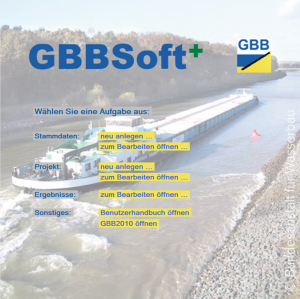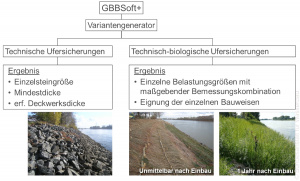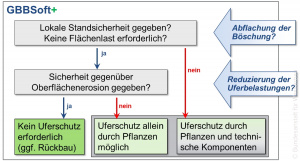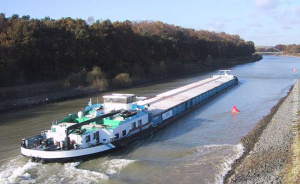Design Software: Difference between revisions
From BAWiki
Created page with "de:Bemessungssoftware Design software is used for a practical application of recommendations and computation methods for example from regulations and bulletins to waterway..." |
The LinkTitles extension automatically added links to existing pages (<a target="_blank" rel="nofollow noreferrer noopener" class="external free" href="https://github.com/bovender/LinkTitles">https://github.com/bovender/LinkTitles</a>). |
||
| (3 intermediate revisions by one other user not shown) | |||
| Line 3: | Line 3: | ||
==GBBSoft - Software zur Bemessung von Böschungs- und Sohlensicherungen an Binnenwasserstraßen== | ==GBBSoft - Software zur Bemessung von Böschungs- und Sohlensicherungen an Binnenwasserstraßen== | ||
[[File: BAWiki_Bemessungssoftware1.png|thumb| | [[File: BAWiki_Bemessungssoftware1.png|thumb|Picture 1: Start screen of the GBBSoft software]] | ||
[[File: BAWiki_Bemessungssoftware2.jpg|thumb| | [[File: BAWiki_Bemessungssoftware2.jpg|thumb|Picture 2: Results of designing bank protection measures using GBBSoft+]] | ||
[[File: BAWiki_Bemessungssoftware3.jpg|thumb| | [[File: BAWiki_Bemessungssoftware3.jpg|thumb|Picture 3: Decision tree for selecting technical-biological bank protection measures]] | ||
[[File: BAWiki_Bemessungssoftware4.jpg|thumb| | [[File: BAWiki_Bemessungssoftware4.jpg|thumb|Picture 4: Ship-induced loading, illustrated by a large motorized freight vessel passing close to the bank of the canal]] | ||
In 2008 GBBSoft was introduced in the WSV by means of a decision as a software to design bank and riverbed protection measures for inland waterways for application cases not covered by standard construction methods. The software is based on the BAW’s newsletter no. 87, “Principles for the Design of Bank and Bottom Protection for Inland Waterways” (GBB2004), which was first issued by the BAW in 2004 (Published in English as BAW newsletter no. 88 in 2005).An extensively revised version of GBB2004 was published in 2011 and is available on the BAW’s homepage as BAW Code of Practice GBB2010 (BAW 2011) (BAW Code of Practice GBB2010). The calculation methods and design concepts used in GBB2010 have been incorporated into the software, which was developed in order to shorten and simplify the process of applying GBB2010, particularly when searching for optimum solutions, and to prevent misunderstandings and computing errors when applying what, in some cases, are highly complex algorithms. | In 2008 GBBSoft was introduced in the WSV by means of a decision as a software to design [[bank]] and riverbed protection measures for inland waterways for application cases not covered by standard construction methods. The software is based on the BAW’s newsletter no. 87, “Principles for the Design of [[Bank]] and Bottom Protection for Inland Waterways” (GBB2004), which was first issued by the BAW in 2004 (Published in English as BAW newsletter no. 88 in 2005).An extensively revised version of GBB2004 was published in 2011 and is available on the BAW’s homepage as BAW Code of Practice GBB2010 (BAW 2011) (BAW Code of Practice GBB2010). The calculation methods and design concepts used in GBB2010 have been incorporated into the software, which was developed in order to shorten and simplify the process of applying GBB2010, particularly when searching for optimum solutions, and to prevent misunderstandings and computing errors when applying what, in some cases, are highly complex algorithms. | ||
Current statutory regulations (e.g. the European Water Framework Directive (EC-WFD 2000) and political framework conditions (e.g. those created by the government’s “Blue Ribbon Germany” scheme) encourage and call for measures for renaturing the areas around secondary waterways and for implementing biotope networks along the busy federal waterways. The aim is to enhance the environmental value of the waterways in order to, amongst other things, promote a greater structural diversity as well as biodiversity and the development of habitats that are closer to nature. Making greater use of technical-biological bank protection supports this aim. | Current statutory regulations (e.g. the European [[Water Framework Directive]] (EC-WFD 2000) and political framework conditions (e.g. those created by the government’s “Blue Ribbon Germany” scheme) encourage and call for measures for renaturing the areas around secondary waterways and for implementing biotope networks along the busy federal waterways. The aim is to enhance the environmental value of the waterways in order to, amongst other things, promote a greater structural diversity as well as biodiversity and the development of habitats that are closer to nature. Making greater use of technical-biological [[bank]] protection supports this aim. | ||
In response to this development, the software was given a significant functional upgrade and a new name – GBBSoft+ – in 2015 and 2016. As well as taking account of these latest statutory frameworks, GBBSoft+ also contains a variant generator to create multiple design scenarios simultaneously and enables the user to generate notional trapezoidal profiles from real-life transverse profiles. | In response to this development, the software was given a significant functional upgrade and a new name – GBBSoft+ – in 2015 and 2016. As well as taking account of these latest statutory frameworks, GBBSoft+ also contains a variant generator to create multiple design scenarios simultaneously and enables the user to generate notional trapezoidal profiles from real-life transverse profiles. | ||
Technical-biological bank protection measures are incorporated into GBBSoft+ based on the factsheet DWA-M 519, which the German Association for Water, Wastewater and Waste’s “Technical-biological bank protection along major navigable inland waterways” working group published in 2016 (DWA 2016). This expansion of the software’s content allows users to work out design proposals for technical-biological bank protection measures clearly and without taking up an unreasonable amount of time. | Technical-biological [[bank]] protection measures are incorporated into GBBSoft+ based on the factsheet DWA-M 519, which the German Association for Water, Wastewater and Waste’s “Technical-biological [[bank]] protection along major navigable inland waterways” working group published in 2016 (DWA 2016). This expansion of the software’s content allows users to work out design proposals for technical-biological [[bank]] protection measures clearly and without taking up an unreasonable amount of time. | ||
GBBSoft+ determines the hydraulic loads acting on embankments resulting from the primary and secondary wave field of typical inland navigation vessels (e.g. motorised freight vessels, pushed barge units, sport boats) in stationary movement parallel to the banks in a prismatic, trapezoidal cross-section through the waterway. This calculation task is called “Hydraulic calculation”. | GBBSoft+ determines the hydraulic loads acting on embankments resulting from the primary and secondary wave field of typical inland [[navigation]] vessels (e.g. motorised freight vessels, pushed [[barge]] units, sport boats) in stationary movement parallel to the banks in a prismatic, trapezoidal [[cross-section]] through the [[waterway]]. This calculation task is called “Hydraulic calculation”. | ||
Loads acting on the beds and banks resulting from the propeller wash of the main drive and a bow thruster (propulsion-induced loads) can be calculated for manoeuvre situations at negligible vessel speed for any jet direction. This calculation task is called “Calculate propulsion”. | Loads acting on the beds and banks resulting from the propeller wash of the main drive and a [[bow thruster]] (propulsion-induced loads) can be calculated for manoeuvre situations at negligible vessel speed for any jet direction. This calculation task is called “Calculate propulsion”. | ||
Based on the ship-induced loads either a technical bank protection in accordance with GBB2010 or a technical-biological bank protection in accordance with DWA-M 519 will be designed | Based on the ship-induced loads either a technical [[bank]] protection in accordance with GBB2010 or a technical-biological [[bank]] protection in accordance with DWA-M 519 will be designed. | ||
Technical bank protection is designed in two work steps. With the “hydraulic design”, GBBSoft+ calculates the requisite size and weight of an individual stone in loose rip-rap in order to avoid or at least extensively limit the surface erosion of the rip-rap stones and the movement of each stone near the surface. The subsequent “geotechnical design” is intended to ensure the necessary rip-rap thickness to guarantee local structural stability (preventing the bank from sliding along a failure surface running parallel and close to the surface of the bank and avoiding hydrodynamic soil displacement). Global structural stability is to be calculated separately outside GBBSoft+. Various rip-rap supports can be chosen to improve stability, such as an embedded toe or a toe blanket. For example, the depth of the embedded toe is varied automatically to make it easier for the user to ascertain the optimum rip-rap design. A geotechnical design can also be created without first doing any hydraulic calculations as the effects that are relevant from a geotechnical design perspective can also be entered manually (e.g. measured or empirical values). | Technical [[bank]] protection is designed in two work steps. With the “hydraulic design”, GBBSoft+ calculates the requisite size and weight of an individual stone in loose rip-rap in order to avoid or at least extensively limit the surface [[erosion]] of the rip-rap stones and the movement of each stone near the surface. The subsequent “geotechnical design” is intended to ensure the necessary rip-rap thickness to guarantee local structural stability (preventing the [[bank]] from sliding along a failure surface running parallel and close to the surface of the [[bank]] and avoiding hydrodynamic soil displacement). Global structural stability is to be calculated separately outside GBBSoft+. Various rip-rap supports can be chosen to improve stability, such as an embedded toe or a toe [[blanket]]. For example, the depth of the embedded toe is varied automatically to make it easier for the user to ascertain the optimum rip-rap design. A geotechnical design can also be created without first doing any hydraulic calculations as the effects that are relevant from a geotechnical design perspective can also be entered manually (e.g. measured or empirical values). | ||
When designing technical-biological bank protection, GBBSoft+ first checks whether a bank protection is actually required based on technical criteria (erosion stability, requisite surface weight | When designing technical-biological [[bank]] protection, GBBSoft+ first checks whether a [[bank]] protection is actually required based on technical criteria ([[erosion]] stability, requisite surface weight). The factsheet DWA-M 519 also defines [[bioengineering]] criteria, most of which are derived from experience gained with minor bodies of water with no shipping and used to assess the quality of measures (“recommended”, “recommended with reservations” and “not recommended”). These [[bioengineering]] criteria are stored in GBBSoft+ and, together with the technical criteria, form the basis for evaluating the [[usability]] and dimensioning of, to date, ten technical-biological [[bank]] protection measures. Examining environmental criteria (environmental effectiveness of a measure) is the responsibility of the user. | ||
---- | |||
back to [[Hydraulic Engineering Methods]] | |||
---- | |||
[[Overview]] | |||
Latest revision as of 09:58, 21 October 2022
Design software is used for a practical application of recommendations and computation methods for example from regulations and bulletins to waterways engineering and hydraulic engineering in inland areas. As a rule, design software combines theoretical and empirical approaches with the results of practical experience. Together with computing results for various loading scenarios, it intends to provide the user with a dimensioning proposal for his specific problem.
GBBSoft - Software zur Bemessung von Böschungs- und Sohlensicherungen an Binnenwasserstraßen




In 2008 GBBSoft was introduced in the WSV by means of a decision as a software to design bank and riverbed protection measures for inland waterways for application cases not covered by standard construction methods. The software is based on the BAW’s newsletter no. 87, “Principles for the Design of Bank and Bottom Protection for Inland Waterways” (GBB2004), which was first issued by the BAW in 2004 (Published in English as BAW newsletter no. 88 in 2005).An extensively revised version of GBB2004 was published in 2011 and is available on the BAW’s homepage as BAW Code of Practice GBB2010 (BAW 2011) (BAW Code of Practice GBB2010). The calculation methods and design concepts used in GBB2010 have been incorporated into the software, which was developed in order to shorten and simplify the process of applying GBB2010, particularly when searching for optimum solutions, and to prevent misunderstandings and computing errors when applying what, in some cases, are highly complex algorithms.
Current statutory regulations (e.g. the European Water Framework Directive (EC-WFD 2000) and political framework conditions (e.g. those created by the government’s “Blue Ribbon Germany” scheme) encourage and call for measures for renaturing the areas around secondary waterways and for implementing biotope networks along the busy federal waterways. The aim is to enhance the environmental value of the waterways in order to, amongst other things, promote a greater structural diversity as well as biodiversity and the development of habitats that are closer to nature. Making greater use of technical-biological bank protection supports this aim.
In response to this development, the software was given a significant functional upgrade and a new name – GBBSoft+ – in 2015 and 2016. As well as taking account of these latest statutory frameworks, GBBSoft+ also contains a variant generator to create multiple design scenarios simultaneously and enables the user to generate notional trapezoidal profiles from real-life transverse profiles.
Technical-biological bank protection measures are incorporated into GBBSoft+ based on the factsheet DWA-M 519, which the German Association for Water, Wastewater and Waste’s “Technical-biological bank protection along major navigable inland waterways” working group published in 2016 (DWA 2016). This expansion of the software’s content allows users to work out design proposals for technical-biological bank protection measures clearly and without taking up an unreasonable amount of time.
GBBSoft+ determines the hydraulic loads acting on embankments resulting from the primary and secondary wave field of typical inland navigation vessels (e.g. motorised freight vessels, pushed barge units, sport boats) in stationary movement parallel to the banks in a prismatic, trapezoidal cross-section through the waterway. This calculation task is called “Hydraulic calculation”.
Loads acting on the beds and banks resulting from the propeller wash of the main drive and a bow thruster (propulsion-induced loads) can be calculated for manoeuvre situations at negligible vessel speed for any jet direction. This calculation task is called “Calculate propulsion”.
Based on the ship-induced loads either a technical bank protection in accordance with GBB2010 or a technical-biological bank protection in accordance with DWA-M 519 will be designed.
Technical bank protection is designed in two work steps. With the “hydraulic design”, GBBSoft+ calculates the requisite size and weight of an individual stone in loose rip-rap in order to avoid or at least extensively limit the surface erosion of the rip-rap stones and the movement of each stone near the surface. The subsequent “geotechnical design” is intended to ensure the necessary rip-rap thickness to guarantee local structural stability (preventing the bank from sliding along a failure surface running parallel and close to the surface of the bank and avoiding hydrodynamic soil displacement). Global structural stability is to be calculated separately outside GBBSoft+. Various rip-rap supports can be chosen to improve stability, such as an embedded toe or a toe blanket. For example, the depth of the embedded toe is varied automatically to make it easier for the user to ascertain the optimum rip-rap design. A geotechnical design can also be created without first doing any hydraulic calculations as the effects that are relevant from a geotechnical design perspective can also be entered manually (e.g. measured or empirical values).
When designing technical-biological bank protection, GBBSoft+ first checks whether a bank protection is actually required based on technical criteria (erosion stability, requisite surface weight). The factsheet DWA-M 519 also defines bioengineering criteria, most of which are derived from experience gained with minor bodies of water with no shipping and used to assess the quality of measures (“recommended”, “recommended with reservations” and “not recommended”). These bioengineering criteria are stored in GBBSoft+ and, together with the technical criteria, form the basis for evaluating the usability and dimensioning of, to date, ten technical-biological bank protection measures. Examining environmental criteria (environmental effectiveness of a measure) is the responsibility of the user.
back to Hydraulic Engineering Methods
